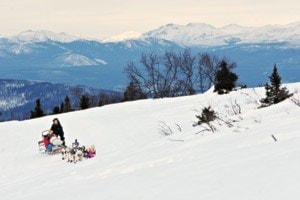PELLY CROSSING
Since its inception in ’84, the Yukon Quest has either started or finished in Whitehorse.
This year, it won’t.
There just is not enough snow south of Carmacks, making the trail unsafe for mushers and teams.
“I have opened the trail from the Alaskan border to Whitehorse every year since the Quest started,” said senior ranger John Mitchell.
“And this is the toughest trail I have ever seen.”
On Friday, mushers and officials met and after discussing various possibilities voted on whether to finish the race at Pelly, 320 kilometres from Dawson, or to run to Pelly and then return to Dawson for the finish.
“It was a very close call,” said Hans Gatt.
By a slim majority mushers voted to return to Dawson.
“Stopping in Pelly would have cut the race short — it would have been an advantage to some mushers and not to others,” said Lance Mackey, who left Dawson in first place.
“It makes for more of a level playing field, and gives everyone more time,” said veteran musher Frank Turner, who attended the meeting.
“If the race had stopped in Pelly it would have done more to freeze existing positions.”
But Michelle Philips, who was a good 12 hours behind the front runners, would have rather seen the race end in Pelly.
“It is hard to bring the dogs back on the same trail they have just run on, it’s demoralizing for them,” she said.
“And I’m worried about their attitude, this is really important for the race too.”
“At least we are running into Pelly on the farm road and leaving on the river, so the dogs won’t know we have turned around right away,” said Gerry Willomitzer.
“But it’s going to be tough, because you have to cross those hills back and forth.”
The trail to Pelly crosses the highest summit in the race, King Solomon’s Dome, elevation 1,200 metres. And shortly thereafter it tackles the Black Hills, which are more like mountains.
“In the Black Hills, you have to climb Eureka Dome, which nobody talks about,” said Willomitzer.
“But it’s a big sucker — it’s a climb.”
“Coming back there are a lot of hills, the black hills are lots of climbing,” agreed Turner.
“And it’s going to take lots of strategy — you don’t want to run dogs straight out, or you’re going to lose power.”
Before the Quest finishes, there is always a mandatory eight-hour layover at the last checkpoint, which is Angel Creek or Braeburn depending on the direction of that year’s race.
From either checkpoint it is roughly 160 kilometres to the finish.
This year, because the race is finishing in Dawson the mandatory layover and vet check will take place at Scroggie Creek, a fly-in outpost that is usually just a dog drop.
From Scroggie to Dawson it’s also roughly 160 kilometres.
But there is a major difference.
From Scroggie, the race trail climbs several major mountains, while the race trail from Braeburn and from Angel Creek is relatively flat.
“Deciding to have the eight-hour rest in Scroggie is not dog-friendly,” said Willomitzer.
He fears some mushers will try to race from Scroggie to the finish without stopping.
“And it’s not like Braeburn, when people race straight through,” he said.
“There it’s a relatively flat run, but from Scroggie these dogs will have just done 300 miles of hills.
“They will have hills coming out their ears.”
Because race officials were already flying vets and gear into Scroggie as a dog drop, it was easier for them to choose Scroggie as the mandatory layover, he said.
“It’s more convenient for them, but it’s a poor decision.
“It’s not a way to get good looking dog teams coming across the finish line.”
But race marshal Mike McCowan is not too concerned.
“Everyone has to run it according to the condition of their dogs,” he said.
“And if the dogs are responding, fine. And if they’re not, then back off.
“Mushers can’t make ’em do it, that’s not how it works — if you push a dog too hard, that dog stops.”
Strategy is everything, and it’ll be interesting to see which mushers do long runs and rest coming in and which do short runs and rest, he added.
